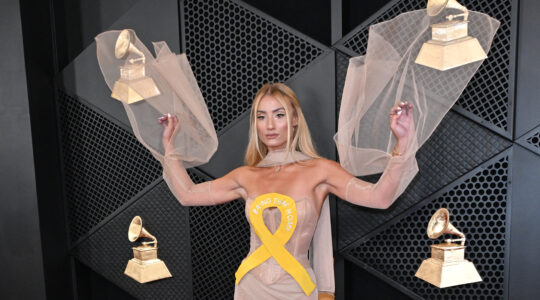SAO PAULO, Brazil, Dec. 24 (JTA) — Mayim, mayim, mayim, mayim. Brazil is not usually considered to be one of the worldwide centers of cultural Jewish life. But the country recently hosted what is believed to be the largest Jewish dance festival outside Israel. The 22nd annual Carmel Festival gathered 83 dance groups, comprising some 2,500 dancers, from Brazil, the United States and Mexico earlier this month for the event at the Hebraica club in Sao Paulo, the center of Jewish life for the city’s 60,000 Jews. It also drew some 20,000 spectators. Gerson Lerner, director of the Hagshamah Department of the World Zionist Organization in Sao Paulo, isn’t a dancer, but he has been involved in the Carmel Festival for the past 16 years. For four years in a row, he has been the producer of Carmel Radio, which broadcasts information about the festival, jokes, interviews and plenty of Israeli music during the three-day event. “Israeli dance is a major activity to all Jewish youth that brings together people around dancing, but above all keeps alive Jewish culture and tradition. This also strengthens ties with Israel,” Lerner said. The general director of the festival for the past 15 years is an Argentine who lives in Brazil. “I don’t dance, but I enjoy the dances. They are the artistic expression of Zionism with the feet,” Gaby Milesvsky said. The 50 hours of the festival offered two evening gala shows, five smaller afternoon shows, teaching sessions and a dance marathon. The theme of this year’s festival was hope. That’s also the name of a primetime soap opera on Brazil’s major TV channel, in which a Jewish family plays a major role and whose soundtrack includes Hebrew songs. For the first time, the Mexican group Anajnu VeAtem brought its 26 dancers and one singer to Brazil to participate in the festival. Created in 1971, the group is considered the oldest in Latin America. Both U.S. and Mexican dancers performed solely at a special show held Saturday night before the night-long dance marathon. For the second year, two groups from the United States came to Sao Paulo exclusively to perform at the Carmel festival. The Hemshech and Jewish Art & Movement groups, both of which represent the Michael-Ann Russel Jewish Community Center of Miami, are choreographed by Roger Weiger. The former group performs traditional Jewish folk dance, while the latter performs more modern interpretations. According to Weiger, 32, most of the groups’ 20 members came to Miami from Latin American countries including Colombia, Venezuela, Panama, Argentina and Peru. Weiger himself is a native of Rio de Janeiro who has been living in the United States since 1993. Alberto Worcman, 42, teaches Israeli folk dance at two Jewish schools in Sao Paulo and is responsible for 15 groups that performed at the Carmel. The continuity of Israeli dance is threatened in Brazil, he says. “People usually stop dancing very early, usually in their 20s. Hardly ever do we find people of all ages dancing together like here. And when it does happen, it’s an isolated event, like a festival,” Worcman said. Financial support is a concern among Brazilian Jewish dance groups — and one that has become more serious with the country’s recent economic difficulties. “The level of support that Jewish institutions are able to provide today is pretty much related to the current economic situation that the country is going through,” said Lehakat Chai’s choreographer Mauricio Salem, who is based in Rio. “As educators, we would certainly be glad with a better infrastructure, but we must understand the reality.” The dancers spun, hopped and twirled to traditional horas, as well as Chasidic, Ladino, Yemenite, Moroccan, Russian, Kurdish and several other styles. Founded in 1985, Ofakim — Hebrew for “horizons” — is a 120-member seniors group. “The group is an example for the next generations. Children look at Ofakim and see that they will be able to dance for as long as they wish,” choreographer Adriana Gordon explained. Fanny Lea Lucki, 70, is the oldest member of Ofakim. “It’s therapy. We dance and have a lot of fun among dear friends. Dance to me means life,” she said. Gordon agrees. “The social aspect is very strong, at both good and bad times,” she said. “We go out together, we celebrate the Jewish holidays together, from the happy ones likes Purim to the sad ones like Yom Hashoah.” Israeli dance in Brazil is mostly performed by Jews — but not exclusively. Pablo Fonseca, 25, is a non-Jew who has been involved with Israeli folk dance for some 10 years and today teaches adults in Porto Alegre, in the south of Brazil. “I had a group of Jewish friends and I started to dance among them. Today I feel Jewish,” he says. Fonseca is a member of Lehakat Kadima, one of the best-known Brazilian Israeli dance groups. “Israeli dance plays a major role in integrating people from different countries,” said Fonseca, who is currently dating a Jewish girl he met dancing — his third such girlfriend.

Help ensure Jewish news remains accessible to all. Your donation to the Jewish Telegraphic Agency powers the trusted journalism that has connected Jewish communities worldwide for more than 100 years. With your help, JTA can continue to deliver vital news and insights. Donate today.





